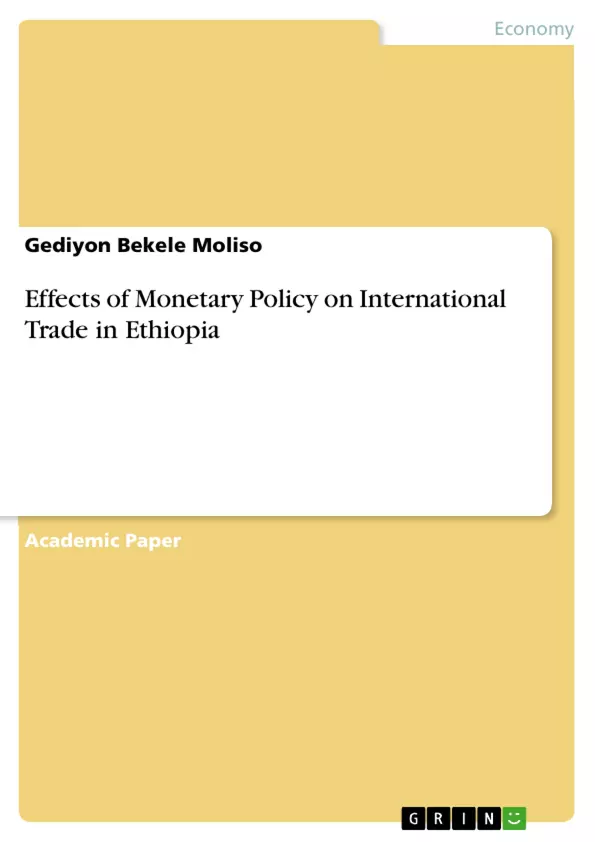This study examined the effect of monetary policies on Total Trade (proxy of international trade) in Ethiopia between 1989 to 2019.International trade was captured using Total Trade (proxy of international trade) while the independent variables that described the various macroeconomic policies in Ethiopia were money supply, exchange rate, real lending rate and inflation rate. Time series data on the variables of the study was gotten from Annual reports of the National Bank of Ethiopia (NBE) from 1989-2019. The secondary data was analyzed using E-views 9.0 software. A model was formulated for the study. The Augmented Dickey Fuller (ADF) stationary test showed that the variables in the study were stable at both levels and at first difference. The regression of the independent variables with Total Trade (proxy of international trade) showed the existence of a long run relationship. Using the Autoregressive Distribute Model (ARDL), the empirical results money supply exerts a significant positive effect on Total Trade (proxy of international trade) in the long run while real lending rate and inflation rate exerts a significant negative effect on Total Trade (proxy of international trade) in the long run and Total Trade (proxy of international trade) one period lag of the variable significantly affects the Total Trade (proxy of international trade) in the short run. LagTT or D(LTT(-1)), a one percent increase in expectation push Total Trade (proxy of international trade) by 51% in short run. This result is similar to the theory of adaptive expectations, they states that individuals will form future expectations based on past events. The study thus concluded that the monetary policy channels through which Total Trade (proxy of international trade) in Ethiopia can be influenced are money supply, lending rate and inflation rate. The study testes all the diagnostic test like serial correlation, Normality, heteroschedasticity and stability. The estimate of the speed of adjustment coefficient found in this study indicates that about a 75% of the variation in the Total Trade (proxy of international trade) from its equilibrium level is corrected within a year.
Inhaltsverzeichnis (Table of Contents)
- CHAPTER ONE
- 1.1 INTRODUCTION
- 1.2 Statement Problem
- 1.3 Objectives
- 1.3.1 General Objectives
- 1.3.2 Specific Objectives
- 1.4. Scope of the Study
- 1.5. Significance of the Study
- 1.6. Organization of the Study
- CHAPTER TWO
- 2. LITERATURE REVIEW
- 2.1. Theoretical Literature
- 2.2 Empirical Review
- CHAPTER THREE
- 3. Research Methodology
- 3.1. Data Source
- 3.2. Model specification
- 3.3. Estimation Method
- 3.3.1 Unit roots
- 3.4 Diagnostic Tests
- CHAPTER FOUR
- 4. Estimated Results and Interpretation
- 4.1 Unit Root Test
- 4.2. Testing for Bounds Test or Co-Integration
- 4.3. Diagnostic test Checking
- 4.4. Long run model
- 4.5 Short Run/Error Correction Model
- CHAPTER FIVE
- 5.1 CONCLUSIONS
- 5.2 RECOMMENDATIONS
Zielsetzung und Themenschwerpunkte (Objectives and Key Themes)
This study aims to investigate the impact of monetary policy on international trade in Ethiopia. Using a combination of economic modeling and statistical analysis, the research aims to identify the relationships between monetary policy tools and trade flows. The study focuses on the role of the National Bank of Ethiopia (NBE) in influencing trade patterns and explores the effectiveness of different monetary policy instruments, such as interest rates and money supply.
- Impact of Monetary Policy on International Trade
- Analysis of the Relationship between Monetary Policy and Trade Flows
- Effectiveness of Monetary Policy Instruments
- Role of the National Bank of Ethiopia (NBE) in Influencing Trade
- Statistical Analysis of Trade Patterns in Ethiopia
Zusammenfassung der Kapitel (Chapter Summaries)
- CHAPTER ONE: This chapter introduces the study, outlining the problem statement, research objectives, scope, significance, and organization of the study. It establishes the context for the research and sets the stage for the subsequent chapters.
- CHAPTER TWO: This chapter presents a comprehensive review of existing literature related to the topic, including both theoretical and empirical studies. It examines past research findings and theories relevant to the relationship between monetary policy and international trade.
- CHAPTER THREE: This chapter details the research methodology employed in the study, including data sources, model specifications, estimation methods, and diagnostic tests. It provides a thorough explanation of the analytical approach used to analyze the data.
- CHAPTER FOUR: This chapter presents the estimated results of the study, interpreting the findings and analyzing the relationship between monetary policy and international trade in Ethiopia. It examines the impact of various monetary policy instruments on trade flows.
Schlüsselwörter (Keywords)
This research focuses on the impact of monetary policy on international trade in Ethiopia. Key terms include: monetary policy, international trade, Ethiopia, National Bank of Ethiopia (NBE), interest rates, money supply, trade flows, econometric modeling, statistical analysis, unit root test, co-integration, error correction model, exchange rates, import, export, GDP, and trade balance.
- Quote paper
- Gediyon Bekele Moliso (Author), 2021, Effects of Monetary Policy on International Trade in Ethiopia, Munich, GRIN Verlag, https://www.grin.com/document/1143539



